tyre pressure Peugeot Partner Tepee 2015 Owner's Manual
[x] Cancel search | Manufacturer: PEUGEOT, Model Year: 2015, Model line: Partner Tepee, Model: Peugeot Partner Tepee 2015Pages: 276, PDF Size: 12.76 MB
Page 7 of 276
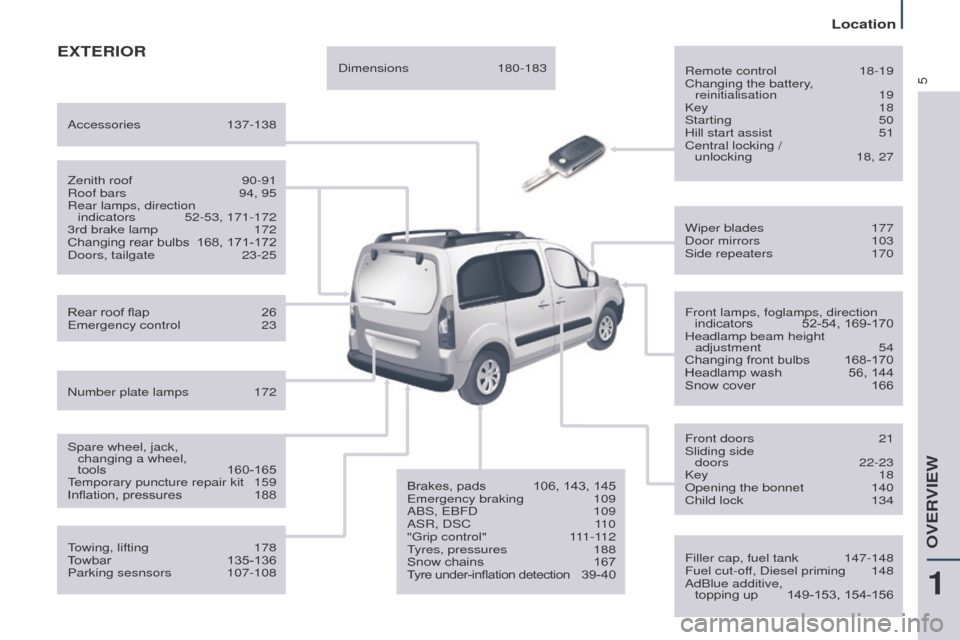
5
Partner_2_VP_en_Chap01_vue-ensemble_ed02-2014
EXTERIOR
Remote control 18-19
Changing the battery ,
reinitialisation
19
Key
18
Starting
50
Hill start assist
51
Central locking /
unlocking
18, 27
Filler cap, fuel tank
147-148
Fuel cut-of
f, Diesel priming
148
AdBlue additive,
topping up
149-153, 154-156
Wiper blades
177
Door mirrors
103
Side repeaters
170
Front lamps, foglamps, direction indicators
52-54, 169-170
Headlamp beam height adjustment
54
Changing front bulbs
168-170
Headlamp wash
56, 144
Snow cover
166
Front doors
21
Sliding side
doors
22-23
Key
18
Opening the bonnet
140
Child lock
134
towing, lifting
178
T
owbar
135-136
Parking sesnsors
107-108
Rear roof flap
26e
mergency control
23
Spare wheel, jack,
changing a wheel,
tools
160-165temporary puncture repair kit
159
Inflation, pressures
188
Zenith roof
90-91
Roof bars
94, 95
Rear lamps, direction
indicators
52-53, 171-172
3rd brake lamp
172
Changing rear bulbs
168, 171-172
Doors, tailgate
23-25
Accessories
137-138
Number plate lamps
172 Dimensions
180-183
Brakes, pads
106, 143, 145e
mergency braking
109
ABS,
e
BFD
109
ASR, DSC
1
10
"
g
rip control"
1
11-112
tyres, pressures
188
Snow chains
167
T
yre under-inflation detection
3
9-40
1
OVeRVIeW
Location
Page 19 of 276
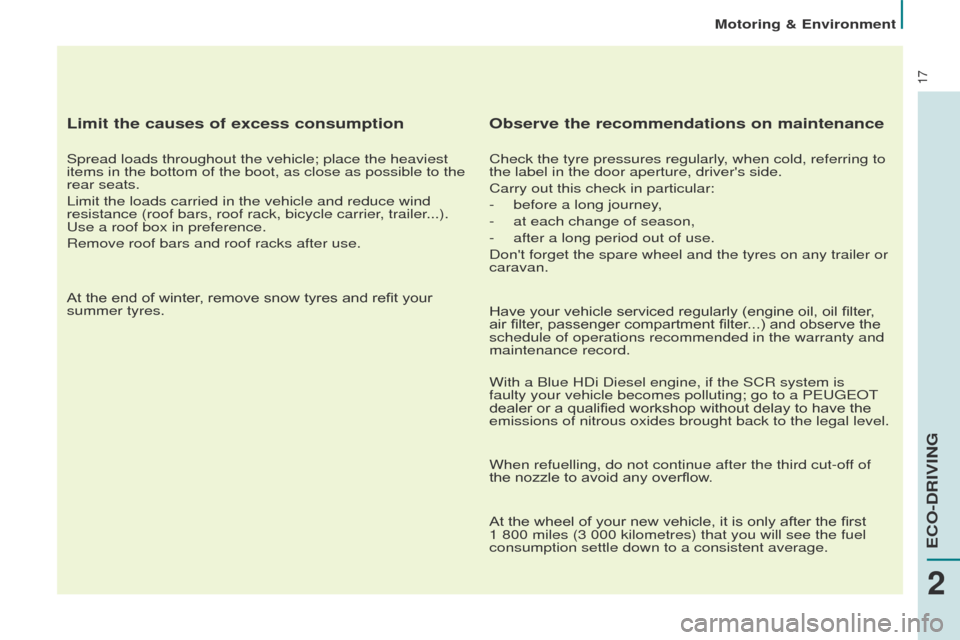
17
Limit the causes of excess consumption
Spread loads throughout the vehicle; place the heaviest
items in the bottom of the boot, as close as possible to the
rear seats.
Limit the loads carried in the vehicle and reduce wind
resistance (roof bars, roof rack, bicycle carrier, trailer...).
u
se a roof box in preference.
Remove roof bars and roof racks after use.
At the end of winter, remove snow tyres and refit your
summer tyres.
Observe the recommendations on maintenance
Check the tyre pressures regularly, when cold, referring to
the label in the door aperture, driver's side.
Carry out this check in particular:
-
before a long journey
,
-
at each change of season,
-
after a long period out of use.
Don't forget the spare wheel and the tyres on any trailer or
caravan.
Have your vehicle serviced regularly (engine oil, oil filter
,
air filter, passenger compartment filter...) and observe the
schedule of operations recommended in the warranty and
maintenance record.
With a Blue HDi Diesel engine, if the SCR system is
faulty your vehicle becomes polluting; go to a P
euge O t
dealer or a qualified workshop without delay to have the
emissions of nitrous oxides brought back to the legal level.
When refuellin
g, do not continue after the third cut-off of
the nozzle to avoid any overflow.
At the wheel of your new vehicle, it is only after the first
1 800 miles (3 000 kilometres) that you will see the fuel
consumption settle down to a consistent average.
2
eCO-DRIVINg
Motoring & environment
Page 35 of 276
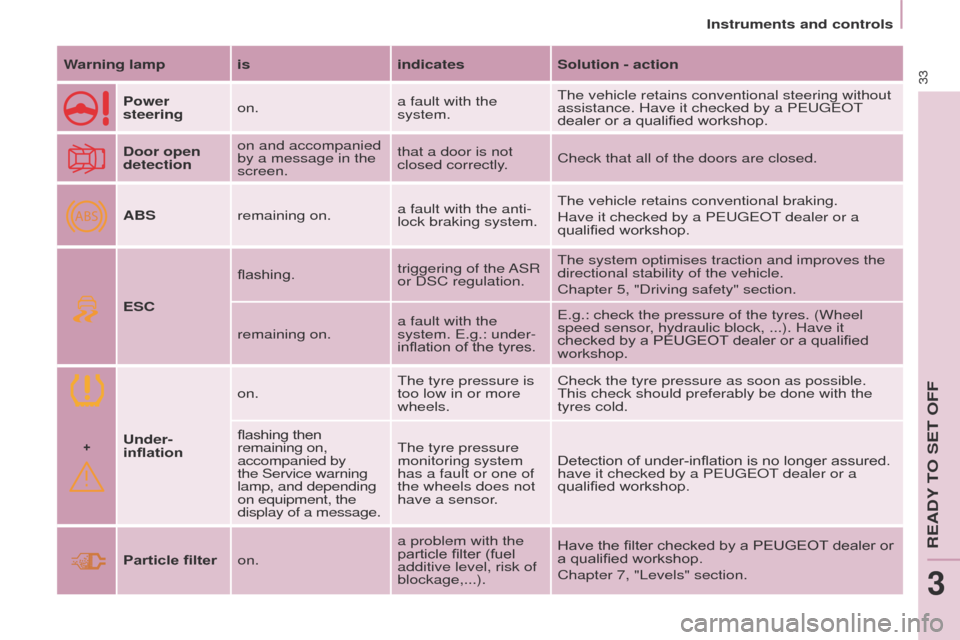
+
ABS
33
Partner_2_VP_en_Chap03_Pret-a-partir_ed02-2014
Warning lamp isindicatesSolution - action
Power
steering on. a fault with the
system.
t
he vehicle retains conventional steering without
assistance. Have it checked by a P
euge O t
dealer or a qualified workshop.
Door open
detection on and accompanied
by a message in the
screen. that a door is not
closed correctly
.Check that all of the doors are closed.
ABS remaining on. a fault with the anti-
lock braking system.
t
he vehicle retains conventional braking.
Have it checked by a P
euge O t
dealer or a
qualified workshop.
ESC flashing.
triggering of the
ASR
or DSC regulation.
t
he system optimises traction and improves the
directional stability of the vehicle.
Chapter 5, "Driving safety" section.
remaining on. a fault with the
system.
e .g.: under-
inflation of the tyres.
e
.g.: check the pressure of the tyres. (Wheel
speed sensor, hydraulic block, ...). Have it
checked by a PEUGEOT dealer or a qualified
workshop.
Under-
inflation on.
t
he tyre pressure is
too low in or more
wheels. Check the tyre pressure as soon as possible.
t
his check should preferably be done with the
tyres cold.
flashing then
remaining on,
accompanied by
the Service warning
lamp, and depending
on equipment, the
display of a message.
t
he tyre pressure
monitoring system
has a fault or one of
the wheels does not
have a sensor. Detection of under-inflation is no longer assured.
have it checked by a P
euge O t
dealer or a
qualified workshop.
Particle filter on. a problem with the
particle filter (fuel
additive level, risk of
blockage,...).Have the filter checked by a PEUGEOT
dealer or
a qualified workshop.
Chapter 7, "Levels" section.
Instruments and controls
READY TO SET OFF
3
Page 41 of 276
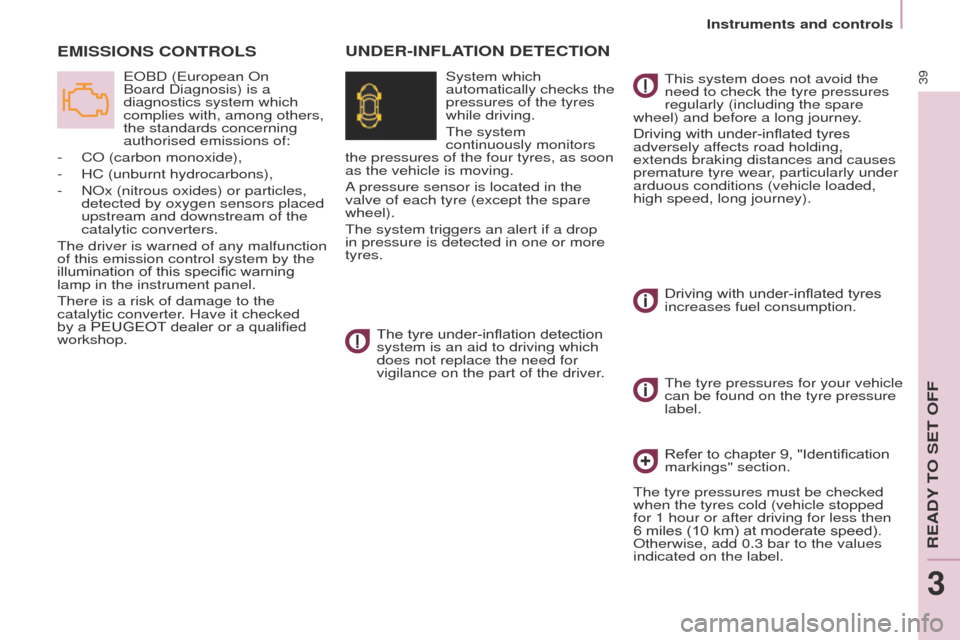
39
Partner_2_VP_en_Chap03_Pret-a-partir_ed02-2014
EMISSIONS CONTROLS
eOBD (european On
Board Diagnosis) is a
diagnostics system which
complies with, among others,
the standards concerning
authorised emissions of:
-
CO (carbon monoxide),
-
HC (unburnt hydrocarbons),
-
NOx (nitrous oxides) or particles,
detected by oxygen sensors placed
upstream and downstream of the
catalytic converters.
t
he driver is warned of any malfunction
of this emission control system by the
illumination of this specific warning
lamp in the instrument panel.
t
here is a risk of damage to the
catalytic converter. Have it checked
by a PEUGEOT dealer or a qualified
workshop.
UNDER-INFLATION DETECTION
System which
automatically checks the
pressures of the tyres
while driving.
t
he system
continuously monitors
the pressures of the four tyres, as soon
as the vehicle is moving.
A pressure sensor is located in the
valve of each tyre (except the spare
wheel).
t
he system triggers an alert if a drop
in pressure is detected in one or more
tyres.
The tyre under-inflation detection
system is an aid to driving which
does not replace the need for
vigilance on the part of the driver
.t his system does not avoid the
need to check the tyre pressures
regularly (including the spare
wheel) and before a long journey.
Driving with under-inflated tyres
adversely affects road holding,
extends braking distances and causes
premature tyre wear, particularly under
arduous conditions (vehicle loaded,
high speed, long journey).
Driving with under-inflated tyres
increases fuel consumption.
t
he tyre pressures for your vehicle
can be found on the tyre pressure
label.
Refer to chapter 9, "Identification
markings" section.
t
he tyre pressures must be checked
when the tyres cold (vehicle stopped
for 1 hour or after driving for less then
6 miles (10 km) at moderate speed).
Otherwise, add 0.3 bar to the values
indicated on the label.
Instruments and controls
ReADY tO Set OFF
3
Page 42 of 276

40
Partner_2_VP_en_Chap03_Pret-a-partir_ed02-2014
the alert is maintained until
the tyre or tyres concerned is
reinflated, repaired or replaced.
t
he spare wheel (space-saver
type or a steel rim) does not have a
sensor.
Operating fault
Under-inflation alert
the loss of pressure detected
does not always lead to visible
deformation of the tyre. Do not rely
on just a visual check.The alert is given by the fixed
illumination of this warning lamp,
accompanied by an audible signal,
and depending on equipment, the
display of a message.The flashing and then
fixed illumination of the
under-inflation warning
lamp accompanied by the
illumination of the "Service" warning
lamp, and depending on equipment,
the display of a message indicates a
fault with the system.
In this case, monitoring of the tyre
pressures is not assured.
In the event of a problem on one of
the tyres, the symbol or the message
appears, according to equipment, to
identify it.
-
Reduce speed, avoid sudden
steering movements or harsh brake
applications.
-
Stop as soon as it is safe to do so.
-
In the event of a puncture, use
the temporary puncture repair kit
or the spare wheel (according to
equipment),
or
-
if you have a compressor
, the one
in the temporary puncture repair
kit for example, check the four tyre
pressures when cold,
or
-
if it is not possible to check the
tyre pressures at the time, drive
carefully at reduced speed.
t
his alert is also displayed when
one or more wheels is not fitted
with a sensor (for example, a
space-saver or steel spare wheel).
g
o to a P euge O t
dealer or a
qualified workshop
to have the system
checked or, following the repair of a
puncture, to have the original wheel,
equipped with a sensor, refitted.
Instruments and controls
Page 111 of 276
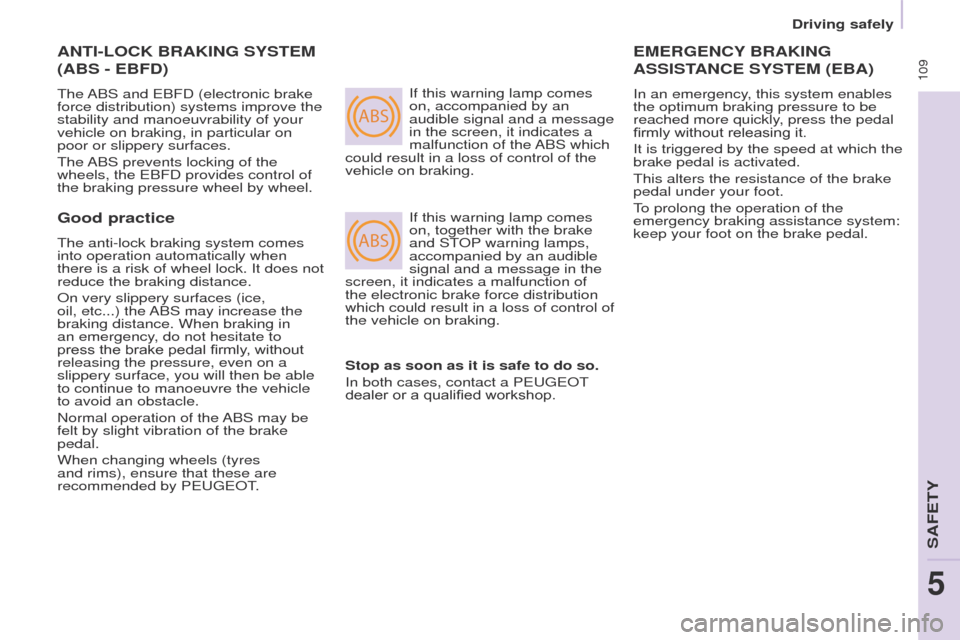
ABS
ABS
109
Partner_2_VP_en_Chap05_Securite_ed02-2014
ANTI-LOCK BRAKING SYSTEM
(ABS - EBFD)
the ABS and eBFD (electronic brake
force distribution) systems improve the
stability and manoeuvrability of your
vehicle on braking, in particular on
poor or slippery surfaces.
t
he ABS prevents locking of the
wheels, the
e BFD provides control of
the braking pressure wheel by wheel. If this warning lamp comes
on, accompanied by an
audible signal and a message
in the screen, it indicates a
malfunction of the ABS which
could result in a loss of control of the
vehicle on braking.
If this warning lamp comes
on, together with the brake
and S
t
OP
warning lamps,
accompanied by an audible
signal and a message in the
screen, it indicates a malfunction of
the electronic brake force distribution
which could result in a loss of control of
the vehicle on braking.
EMERGENCY BRAKING
ASSISTANCE SYSTEM (EBA)
In an emergency, this system enables
the optimum braking pressure to be
reached more quickly, press the pedal
firmly without releasing it.
It is triggered by the speed at which the
brake pedal is activated.
t
his alters the resistance of the brake
pedal under your foot.
to prolong the operation of the
emergency braking assistance system:
keep your foot on the brake pedal.Good practice
the anti-lock braking system comes
into operation automatically when
there is a risk of wheel lock. It does not
reduce the braking distance.
On very slippery surfaces (ice,
oil,
etc...) the ABS may increase the
braking distance. When braking in
an emergency, do not hesitate to
press the brake pedal firmly, without
releasing the pressure, even on a
slippery surface, you will then be able
to continue to manoeuvre the vehicle
to avoid an obstacle.
Normal operation of the ABS may be
felt by slight vibration of the brake
pedal.
When changing wheels (tyres
and rims), ensure that these are
recommended by P
euge O t
.Stop as soon as it is safe to do so.
In both cases, contact a P
euge O t
dealer or a qualified workshop.
Driving safely
SAFetY
5
Page 112 of 276
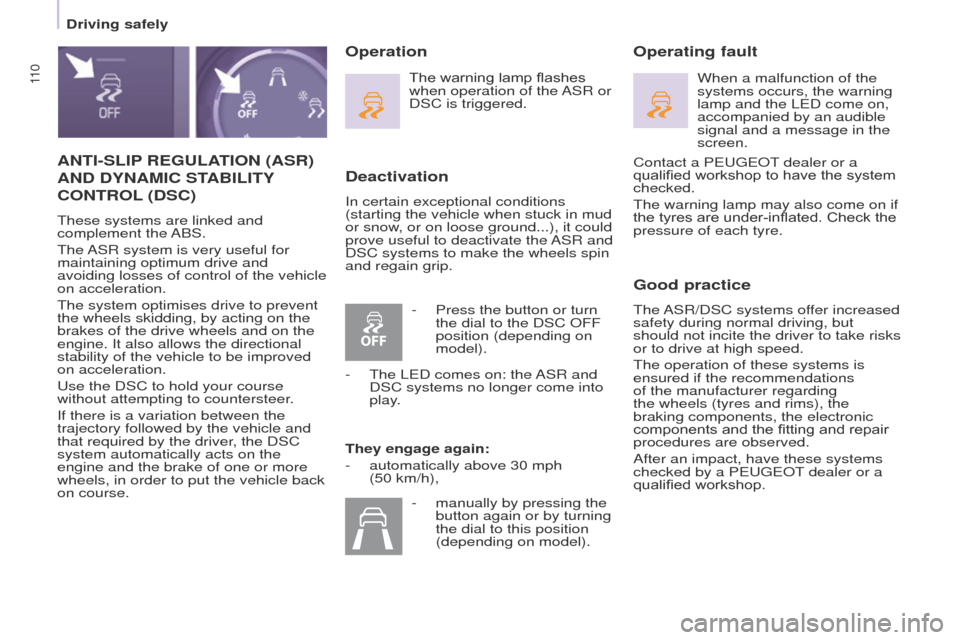
11 0
Partner_2_VP_en_Chap05_Securite_ed02-2014
ANTI-SLIP REGULATION (ASR)
AND DYNAMIC STABILITY
CONTROL (DSC)
these systems are linked and
complement the ABS.
t
he ASR system is very useful for
maintaining optimum drive and
avoiding losses of control of the vehicle
on acceleration.
t
he system optimises drive to prevent
the wheels skidding, by acting on the
brakes of the drive wheels and on the
engine. It also allows the directional
stability of the vehicle to be improved
on acceleration.
u
se the DSC to hold your course
without attempting to countersteer.
If there is a variation between the
trajectory followed by the vehicle and
that required by the driver, the DSC
system automatically acts on the
engine and the brake of one or more
wheels, in order to put the vehicle back
on course.
Deactivation
In certain exceptional conditions
(starting the vehicle when stuck in mud
or snow, or on loose ground...), it could
prove useful to deactivate the ASR and
DSC systems to make the wheels spin
and regain grip.
Operating fault
Good practice
the ASR/DSC systems offer increased
safety during normal driving, but
should not incite the driver to take risks
or to drive at high speed.
t
he operation of these systems is
ensured if the recommendations
of the manufacturer regarding
the wheels (tyres and rims), the
braking components, the electronic
components and the fitting and repair
procedures are observed.
After an impact, have these systems
checked by a P
euge O t
dealer or a
qualified workshop.
Operation
The warning lamp flashes
when operation of the ASR or
DSC is triggered.
They engage again:
-
automatically above 30 mph
(50 km/h), When a malfunction of the
systems occurs, the warning
lamp and the L
e D come on,
accompanied by an audible
signal and a message in the
screen.
-
Press the button or turn
the dial to the DSC OFF
position (depending on
model).
-
t
he L
e D comes on: the ASR and
DSC systems no longer come into
play.
-
manually by pressing the
button again or by turning
the dial to this position
(depending on model). Contact a P
euge O t
dealer or a
qualified workshop to have the system
checked.
t
he warning lamp may also come on if
the tyres are under-inflated. Check the
pressure of each tyre.
Driving safely
Page 138 of 276
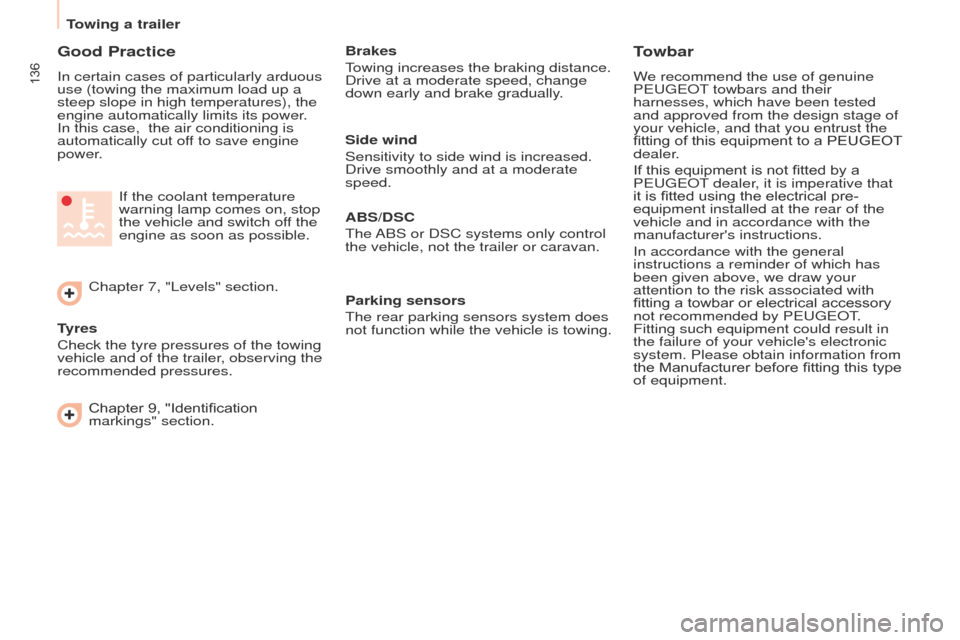
136
Partner_2_VP_en_Chap06_Accessoire_ed02-2014
Good Practice
In certain cases of particularly arduous
use (towing the maximum load up a
steep slope in high temperatures), the
engine automatically limits its power.
In this case, the air conditioning is
automatically cut off to save engine
power.
Tyres
Check the tyre pressures of the towing
vehicle and of the trailer, observing the
recommended pressures. Chapter 7, "Levels" section.If the coolant temperature
warning lamp comes on, stop
the vehicle and switch off the
engine as soon as possible. Brakestowing increases the braking distance.
Drive at a moderate speed, change
down early and brake gradually
.
Towbar
We recommend the use of genuine
Peuge O t towbars and their
harnesses, which have been tested
and approved from the design stage of
your vehicle, and that you entrust the
fitting of this equipment to a PEUGEOT
dealer.
If this equipment is not fitted by a
P
euge O t
dealer
, it is imperative that
it is fitted using the electrical pre-
equipment installed at the rear of the
vehicle and in accordance with the
manufacturer's instructions.
In accordance with the general
instructions a reminder of which has
been given above, we draw your
attention to the risk associated with
fitting a towbar or electrical accessory
not recommended by P
euge O t
.
Fitting such equipment could result in
the failure of your vehicle's electronic
system. Please obtain information from
the Manufacturer before fitting this type
of equipment.
Side wind
Sensitivity to side wind is increased.
Drive smoothly and at a moderate
speed.
ABS/DSC
t
he ABS or DSC systems only control
the vehicle, not the trailer or caravan.
Parking sensors
t
he rear parking sensors system does
not function while the vehicle is towing.
Chapter 9, "Identification
markings" section.
Towing a trailer
Page 161 of 276
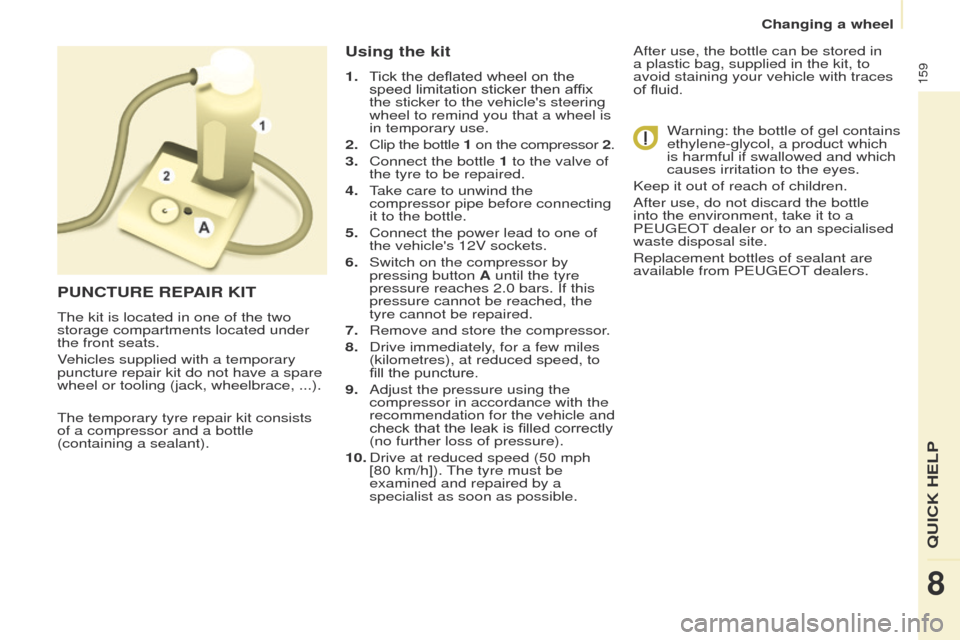
159
Partner_2_VP_en_Chap08_Aide-rapide_ed02-2014
the temporary tyre repair kit consists
of a compressor and a bottle
(containing a sealant).
Using the kit
1. Tick the deflated wheel on the speed limitation sticker then affix
the sticker to the vehicle's steering
wheel to remind you that a wheel is
in temporary use.
2.
Clip the bottle
1 on the compressor
2.
3.
Connect the bottle
1 to the valve of
the tyre to be repaired.
4.
t
ake care to unwind the
compressor pipe before connecting
it to the bottle.
5.
Connect the power lead to one of
the vehicle's 12V sockets.
6.
Switch on the compressor by
pressing button
A until the tyre
pressure reaches 2.0 bars. If this
pressure cannot be reached, the
tyre cannot be repaired.
7.
Remove and store the compressor
.
8.
Drive immediately
, for a few miles
(kilometres), at reduced speed, to
fill the puncture.
9.
Adjust the pressure using the
compressor in accordance with the
recommendation for the vehicle and
check that the leak is filled correctly
(no further loss of pressure).
10.
Drive at reduced speed (50
mph
[80 km/h]).
t
he tyre must be
examined and repaired by a
specialist as soon as possible. After use, the bottle can be stored in
a plastic bag, supplied in the kit, to
avoid staining your vehicle with traces
of fluid.
Warning: the bottle of gel contains
ethylene-glycol, a product which
is harmful if swallowed and which
causes irritation to the eyes.
Keep it out of reach of children.
After use, do not discard the bottle
into the environment, take it to a
P
euge O t
dealer or to an specialised
waste disposal site.
Replacement bottles of sealant are
available from P
euge O t
dealers.
PUNCTURE REPAIR KIT
the kit is located in one of the two
storage compartments located under
the front seats.
V
ehicles supplied with a temporary
puncture repair kit do not have a spare
wheel or tooling (jack, wheelbrace, ...).
Changing a wheel
QuICK HeLP
8
Page 166 of 276
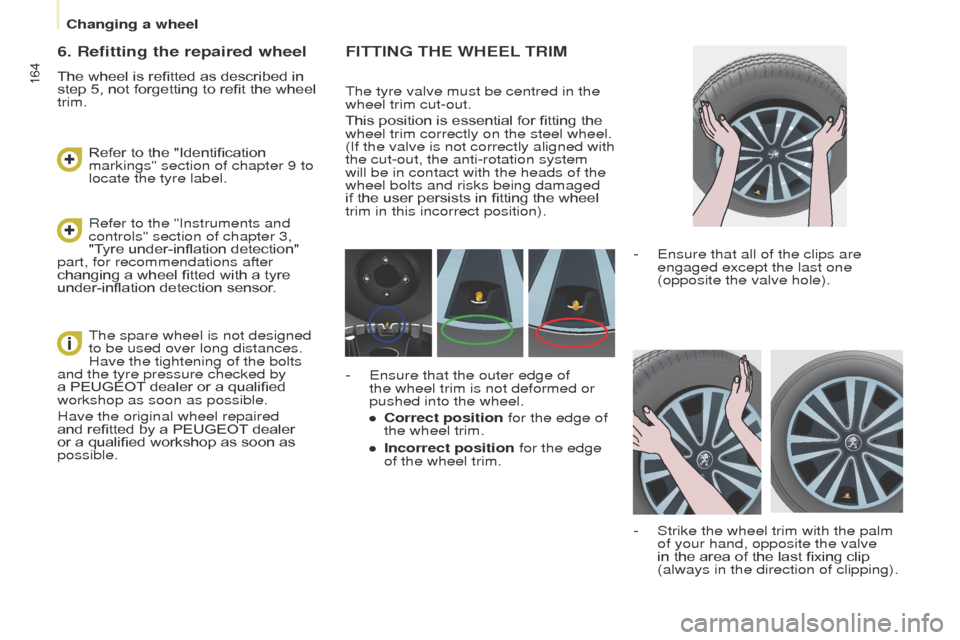
164
Partner_2_VP_en_Chap08_Aide-rapide_ed02-2014
FITTING THE WHEEL TRIM
the tyre valve must be centred in the
wheel trim cut-out.
This position is essential for fitting the
wheel trim correctly on the steel wheel.
(If
the valve is not correctly aligned with
the cut-out, the anti-rotation system
will be in contact with the heads of the
wheel bolts and risks being damaged
if the user persists in fitting the wheel
trim in this incorrect position).
-
e nsure that all of the clips are
engaged except the last one
(opposite the valve hole).
-
Strike the wheel trim with the palm
of your hand, opposite the valve
in the area of the last fixing clip
(always in the direction of clipping).
-
e nsure that the outer edge of
the wheel trim is not deformed or
pushed into the wheel.
●
Correct position
for the edge of
the wheel trim.
●
Incorrect position
for the edge
of the wheel trim.
6. Refitting the repaired wheel
The wheel is refitted as described in
step 5, not forgetting to refit the wheel
trim.
Refer to the "Instruments and
controls" section of chapter 3,
"Tyre under-inflation detection"
part, for recommendations after
changing a wheel fitted with a tyre
under-inflation detection sensor. Refer to the "Identification
markings" section of chapter 9 to
locate the tyre label.
t
he spare wheel is not designed
to be used over long distances.
Have the tightening of the bolts
and the tyre pressure checked by
a PEUGEOT dealer or a qualified
workshop as soon as possible.
Have the original wheel repaired
and refitted by a PEUGEOT dealer
or a qualified workshop as soon as
possible.
Changing a wheel